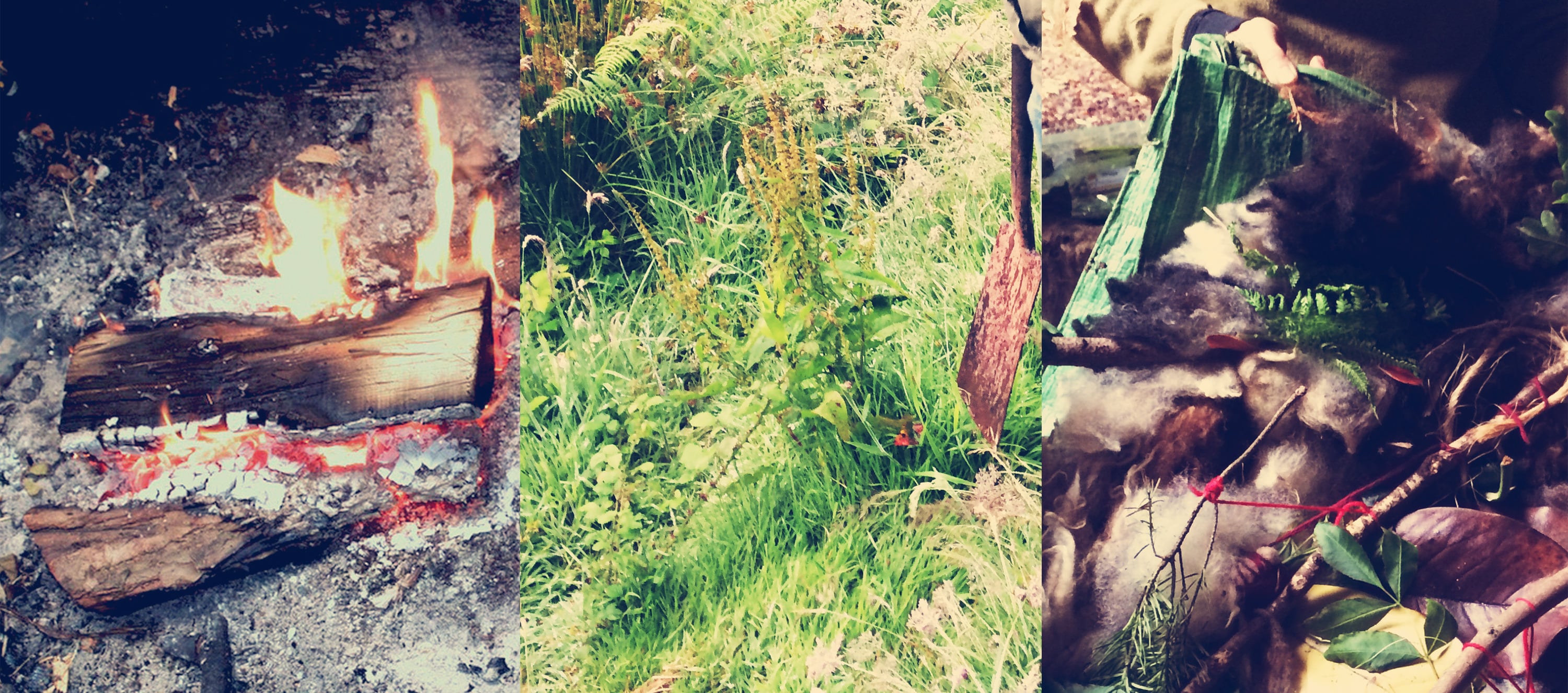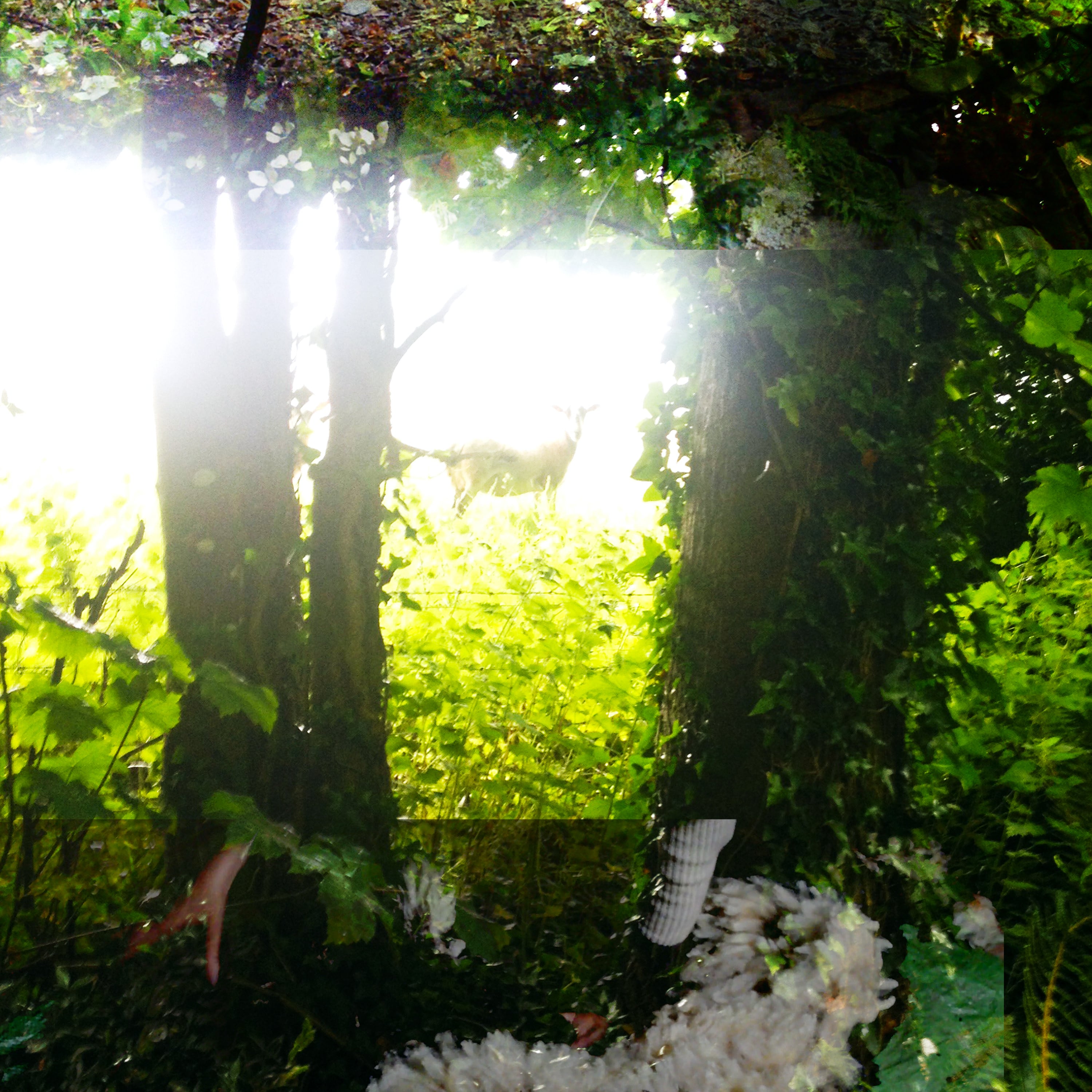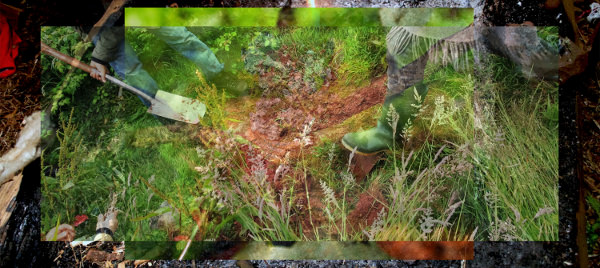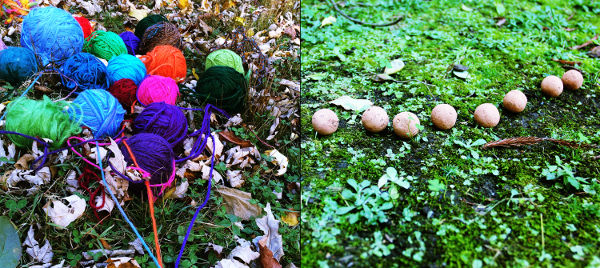
Unearthing / Re-earthing
By BIBI CALDERARO and MARGARETHA HAUGHWOUT of the COASTAL READING GROUP
- View Bibi Calderaro 's Biography
Bibi Calderaro’s artistic practice focuses on participation and collaboration with the more-than-human; she is a PhD candidate at CUNY’s Graduate Center and lives in Brooklyn, NY.
- View Margaretha Haughwout's Biography
Margaretha Haughwout makes social, ecological, and digital art, is Assistant Professor at Colgate
University, and belongs to the Coastal Reading Group.
Unearthing / Re-earthing
By Bibi Calderaro and Margaretha Haughwout of the Coastal Reading Group
The Coastal Reading Group consists of readers, from different literal and metaphorical coasts, who trouble the subjects of wilderness, speciation, humanness, and ways of knowing through diverse engagements with non-humans. The Coastal Reading Group formed in 2015 to engage texts of different disciplines dedicated to the above topics. Over the past 3 years, the CRG expanded the meaning of reading to include the reading of ecologies and of landscapes. Inevitably, this practice now includes other humans and non-humans, thus expanding our understanding of socially engaged practice and allowing for participation in differing capacities and contexts (as participants and conversants in CRG events, or as readers of books, for example). We (the creators of this experimental document) Bibi Calderaro and Margaretha Haughwout, have been with the CRG since its inception. Being from the US and Argentina, we identify as inheritors to colonial legacies. Currently, we both reside in the Northeastern US.
Introduction
In the winter of 2015/2016, the Coastal Reading Group began to formulate questions about how to grieve the staggering loss of non-human species and their ecological habitats that are passing away during this historic, geologic, cultural moment -- in what Donna Haraway and Jason W. Moore call the "Capitalocene". Our initial questions revolved around what relationships have passed unnoticed in this new epoch of extinctions, and whether it is possible to grieve these passings. We wondered (if we could in fact grieve) whether: "[h]olding open space might -- or might not -- delay extinction in ways that make possible composing or recomposing flourishing naturalcultural assemblages," as Donna Haraway puts it (2016:41). We also wondered if grief might have a halting effect on progress as Walter Benjamin seems to suggest in his Theses on the Philosophy of History IX, when he describes how the Angel of History, driven by the storm of progress that simultaneously creates unending catastrophe, would like to stop and tend to the wreckage (1968:257). Through the binaries of modernity, especially that of nature/society, capitalism casts natures as cheap (Moore 2015). If we were to begin to grieve, we would have to learn how to establish relational ecologies between humans and the more-than-human that upend these binaries.1
In addition to these initial questions and speculations, we found in ourselves, and in others, a range of responses to the idea of grief, often manifesting as a dismissal of it, resulting from the perception that grief is not a useful form of resistance, or that it is an emotion equivalent to despair (we found it can sometimes be linked to despair, but not always). Our definition of grief is tied to Vinciane Despret's articulation, here understood through Thom Van Dooren, as "a very particular process of 'learn[ing] to be affected' (131), in which the borders between self, world, and other are profoundly problematized, (209)" and is part of a "becoming-together inside rich histories of biosocial inheritance and relationship" (2014:140). We are also interested in what grief does; "it is through the grief one undergoes that life comes to matter; it is by accepting this grief that it counts" (Despret 2007:87).

A sense of precariousness is, should be, where to start and where to finish. A sense of awe because life and death are intimately related, never separate - when it is said something is alive, it means a life force is touching a death force in a tenuously porous and playful embrace.
Coming from Distances, Unearthing Depths
We found ourselves wondering about distances and depths, lines of connections and fields as meshes of layers. We wondered how the colonial project maintains and conceals itself through distance and depth. The colonial project employs temporal and narratological modes of concealment -- distances and layers -- to prevent the past from emerging into our present. Indeed, there are temporal, ideological and spatial practices that enable this avoidance (Rose 2004). Through specific ecological transformations, perhaps beginning with some sedentary agricultural practices, and certainly through colonization and its market system, a kind of relationship with the non-human has become the norm where distance, through landscape as product (Cosgrove 1989), and the covering of depths through layers of domesticity, are prized; this distance effectively prevents an understanding of the value of the numinous relationships in our midst, and in turn prevents the grief process (Rose 2011; 2004). Unearthing and re-earthing means coming alive (we do not mean to sound nostalgic; but to contend that those of us who identify as inheritors to a colonial legacy must begin to read (and reckon) with our environments: as complex archives of the living, lived, and yet-to-live that long to be set free, in active relation).
Life is always in connection to the lived and yet-to-live. How can we keep this relationship between life and death active, honoring all sides, knowing that they feed and care for each other? A sense of precariousness is, should be, where to start and where to finish. A sense of awe because life and death are intimately related, never separate; when it is said something is alive, it means a life force is touching a death force in a tenuously porous and playful embrace.

On the summer solstice of 2016, the Coastal Reading Group traveled to southern England and developed a plan to explore our questions and suspicions with a larger group. We conceptualized an all night event, outdoors and around a fire, held in conjunction with the Language, Landscape and the Sublime Symposium and Creative Gathering at Schumacher College. In preparation for the night, we traveled to Devon ahead of time to explore the network of human and nonhuman relations at play in the area.
For the weeks leading up to our all-night event, we collected and considered living, lived, and yet-to-live materials implicated in the adoption of agricultural practices leading to deforestation, in regimes of property such as enclosure, and in support of settler-colonization. The collected materials became a temporary archive of ecological transformation, unearthed for the night of the event. Human participants, who hailed mostly from Europe, the US and Canada, but also from parts of the Global South, sat with us from dusk to dawn, working with this archive -- threading seed beads, weaving plant materials, twisting fleece -- while we asked how our array of collected life might dissolve divisions between nature and culture, facilitate decolonization, and deepen intersubjectivity. At dawn, we buried our transformed materials, woven together through the night.
The project, We Weave and Heft by the River, engaged in a spontaneous archival / an-archival process of unearthing and re-earthing materials, stories, and connections between lives of different beings. This unearthing and re-earthing was an active engagement with the possible pasts, presents, and futures that we intuitively or consciously saw to be relevant to our project's aim -- to grieve the immense loss of species and their habitats.
The Coastal Reading Group allowed for a spontaneous mode of access to the collected materials in an attempt to share power and hopefully attract non-human participants too. Jacques Derrida establishes the archive as a place and as a source of power, but also argues that the exposure of its contents can lead to its undoing. In alignment with Derrida, our aim was to reveal this archive in plain sight, and to understand the landscape of England itself as a document of systematic violence and irredeemable loss, thus potentially undoing its power-over (and its simultaneous inaccessibility) (1995).
We re-distributed access to the living, lived, and yet-to-live; the spontaneous "unearthing" and gathering of the materials and the participants complimented the re-earthing/burying of the transformed materials and dissolution of the group by dawn. In this collective project, power (understood as being assumed through access to information and materials, ie. the archive) was assumed, shared and dispersed; so we also went from archive to an-archive through the course of the night. We propose the term 'reckoning' to describe the combined process of acknowledging power dynamics and of grieving.
May we use the term archive to propose a different relationality, and thus transform it? How about saying archive is both mind and body + water and land, materiality and ghost?
This writing is an experimental telling of the archiving and an-archiving: what the authors thought about as we gathered materials and reckoned with different beings in Devon. It is also a partial telling of the event itself -- an occasion that was co-created with symposium delegates, bats, birds, insects, squirrels, as well as many other forest and human ghosts. The following is also a partial archive of living, lived, and yet-to-live relations within a range of economies, that we worked with during We Weave and Heft by the River, and that were implicated in the ecological transformations mentioned above.
For the weeks leading up to our all-night event, we collected and considered living, lived, and yet-to-live materials implicated in the adoption of agricultural practices leading to deforestation, in regimes of property such as enclosure, and in support of settler-colonization.
Sheep
Sheep require fields to graze; they participate in the propagation of grassy landscapes. Sheep compact the ground and inhibit trees and shrubs from growing, which in turn erode soil further (thus continuing the prevention of tree growth and so on in a recursive loop). They often participate in frontier creation, ushering forth treeless pasture, new, less biodiverse plant life, and engagements with docile animals.
We collected sheep's wool as a way of considering how sheep have had a direct relationship to the deforestation and arguably the resultant loss of biodiversity in rural England. Sheep also contribute to the creation of landscape as a product; landscape in England emerges as a commodified form in the 18th-century, with sheep iconically dotting the countryside, and compacting the soil.
Domestic animals play a critical role in colonization and capitalism, through the cheapening function of the frontier, through further justifying the demarcation of property, and often through the transformation of non-human environments from biodiverse ecosystems to docile countryside (Rose 2004). But at the same time, sheep also can signify a shared commons, where people may be less sedentary, and where resources are renewable, thus potentially resisting regimes of property and enabling greater resiliency.
Handling sheep's wool while working over stories, murmurings, and thoughts around the fire put us in touch with contradictions of engagement and connection, and in turn facilitated a process of ongoing reckoning with the domestic species in our midst. The fleece was not skirted and still had sticky, dank lanolin oil all over it. This unprocessed, oily, fleece gave us the sense of being directly in touch with the sheep, especially since it had only recently been sheared and so the fleece was quite literally still part of its body.
Handling this unprocessed, oily, fleece gave us the sense of being directly in touch with the sheep's body...

Hawthorne and Other Plants
We identified and collected many different plant materials throughout the week, plants that had a direct history with enclosure, and sacred plants that are and are known to be used in earth-based spiritual practices. Many plants, predominantly the ones listed below, were collected and then woven into our conversations throughout the night, threaded through seedbeads. Eventually these were buried with the fleece, seedbeads and other natural elements that we thought and sensed with.
Hawthorne - Hawthornes have been collaborating with humans for hundreds of years, in Asia, Europe, North America. The Hawthorne is a profound resource in Europe's commons, with hardwood, medicine, and food all being sourced from this tree (the fruits were called haws, and that's how it got its name). It was used before enclosure in England in the commons, but as the enclosure movement progressed, Hawthornes were used in hedgerows because of their irregular, but big and sharp thorns. It was the hedgerows that blocked commoners from accessing the lands as a resource; hedgerows were a living wall that pushed people to the new, overcrowded industrial cities for work and sustenance.
The plants the Coastal Reading Group used in addition to Hawthorne, are listed below along with some of their (at times) duplicitous colonial/ decolonial associations:
Alder - Wiccan and Druid magick, cleans rivers, water and lymphatic systems, medicine
Dogwood - mourning/ grief (associated with the death of Christ)
Elder - Wiccan magick, hedgerows, medicine (anti-viral), food, Elder flowers are thought to help connect with ancestors
Mugwort - Wiccan magick, activates dreams
Oak - landscape (Capability Brown), English tree magick
Ferns, Magnolia, Nettle seed, Pasture Grass, Pine needles, Yarrow
We identified and collected many different plant materials throughout the week, plants that had a direct history with enclosure, and sacred plants that are and are known to be used in earth-based spiritual practices.
Seeds
Our "seed bead" recipe, a modification of the more common seedballs pioneered by Manusobu Fukuoka (1978) and commonly used in guerrilla gardening practices, included red clay that echoed the abundant red clay beneath our feet in England; local compost collected from nearby gardens; water from the nearby river that flowed past the site; and locally sourced seeds.
Soil is a lot of dead bodies and beings that emerge from them. Water is flow, potentiality. Seed is past and future, depth and height, archive and an-archive.
We used three types of seed: Red Poppy, Blue Cornflower and Red Clover, each culturally and historically significant, and found growing in fields nearby.
Scarlet Corn Poppy: Scarlet corn poppies, Papaver rhoeas, flourish in disturbed soils in Europe. This habit of Papaver rhoeas was first noticed during the Napoleonic wars, where grassy fields turned into fields of blood red poppies, growing around the war dead. In the first World War, Scarlet Corn Poppies proliferated where bombs plunged into the land. Papaver rhoeas came to be regarded as flowers of remembrance, particularly for the war dead because Red Corn Poppies grow where the earth has been disturbed. Perhaps ironically, these plants seems to decrease the production of cereal grains when they grow nearby.
Blue Cornflower: Centaurea cyanus is native to continental Europe and traveled to England in the Iron Age. It has been found in ancient burial sites in Europe from the Neolithic period and it was in abundance all through Europe and England up until the 20th-century, when seed cleaning, pesticides and intensive tilling of land for arable agriculture made it an endangered species. With certain modern land use practices that sow monocrops, require repeated tilling, and the disinfection of seeds and soil in order to do so, species like Centaurea cyanus fall from view. Blue cornflower symbolizes to us the ritual honoring of those unseen species passing away on micro scales, and the passing of species symbiotically linked to those microorganisms. It also manifests here as a reminder of other modes of cultivation that don't require intensive tilling and result in ownership regimes of property. That Centaurea had a resonance with ritual burial was significant to us. We wanted to roll this seed back into the soils of England in some small way.
Red Clover: Red Clover, Trifolium pratense, is used extensively in permaculture practice for bioremediation of soil. Small beads of mycorrhizae grow on the roots of this plant, operating symbiotically with it to fix nitrogen and other beneficial nutrients underground. Red clover is often used in seed balls in urban, guerrilla gardening practices to bioremediate severely disturbed areas in order to lay the basic nutrients required for biodiverse plant life. Medicinally, Trifolium is used by women to block the absorption of harmful environmental xenoestrogens, to cleanse the lymph, and to control the growth of hormone sensitive tumors. In conjunction with Red Corn Poppy and Blue Cornflower, Trifolium pratense creates discursive living commentary between human engagement and kinds of human disturbances that produce aesthetic, medicinal, edible relationships beyond these direct relationships, and that are also symbolic of affective conditions relating to the passing of living things.
Soil is a lot of dead bodies and beings that emerge from them. Water is flow, potentiality. Seed is past and future, depth and height, archive and an-archive.

Schedule
We rolled seedbeads in the days leading up to the overnight. On the afternoon of the event we sorted out and displayed all locally sourced materials to offer them to participants-plant parts, rocks, twigs, wool, yarn, seedbeads, rope. At one edge of the circle, where we would spend the night, we built a hanging structure with twigs, rope and stones. This structure would hold the materials destined to be buried at dawn. We built a fire at the center of a circle, covered by a canvas canopy, to keep us warm and dry throughout the rainy night.
Participants were led to the circle and offered a cup of tea, remaining silent for the initial few minutes. We introduced ourselves and a schedule for the night, explaining the material engagements that participants could contract throughout the night and an ethics of power distribution and reciprocity. From 10PM to 1AM, we worked with the plants, seed beads, and fleece, while telling stories that ranged from personal accounts to observations related to grieving. At 1AM the human participants had the option to depart the circle for bed. The remaining participants napped and kept the fire alive. At 4AM we began the process of adding our woven objects to the hanging structure, slowly and gently completing it. At dawn we unhooked the structure and objects, laid it over a tarp and silently walked out of the woods and towards an open field. We then took turns digging and burying the materials in this unmarked site.
At one edge of the circle, where we would spend the night, we built a hanging structure with twigs, rope and stones. This structure would hold the materials destined to be buried at dawn.
Unexpected Insects
As stories around the fire wove their way into our materials of all sorts and shapes, those of us physically present during the night opened to the presence of memories and ghosts. One such story relayed vivid memories of long family drives ending with cars' grills filled with thick layers of dead insects pressed to them like paper. We suddenly realized that we rarely see skies thick with insects anymore.
One by one, we named insects. We did this for a long time. We named all the insects we could think of. Ticks, mosquitoes, gnats, spiders, black flies, beetles, dung beetles, aphids.... A bat flew through our circle.
We suddenly realized that we rarely see skies thick with insects anymore.
Archiving An-archiving
As Thom Van Dooren and Deborah Bird Rose argue, those of us that have forgotten to grieve, or have lost the ability due to unnoticed or all too rapid ecological transformations, "... seem to have missed the real need for change -the need to relearn the world and our place in it-that death and grieving so often announce" (Van Dooren 2014:141). It follows that grieving in and of itself can enrich the quality of our multispecies relationships. Our grief work sought to reduce the distancing of the past and the distancing of other species; to trace buried dislocations and violences that impinged on our ability to grieve the present (Van Dooren 2014).
Through the Coastal Reading Group's unearthing/ re-earthing process we redistributed power; and we explored the role of grief in human and more-than-human relational processes. We wanted to reckon with the tremendous losses that have accrued as a result of certain relationships and cultivations: loss of connection, species, habitats that come from landscapes that support hierarchies of power and strong binaries between society and nature, civilization and wilderness, knowable and unknowable, domestic and wild. These kinds of domestic, distancing, and frontier engagements cleared the way for the extinctions of today - both through the detachment to a plurality of animals and plants and forage culture, as well as through the neo-colonial project of resource extraction, appropriation, and labor exploitation that creates static, distancing, hard-to-read archives and non-human others that, through their neglect, do not matter. Through exposing an archive of landscape, we attempted to undo its grip. As certain histories are recuperated, they might become reconfigured with these non-human collaborators in new ways to enable biodiversity and enliven relations.
An archive (and its undoing) is conflict and reckoning, stasis and relation, vertical and horizontal axes in causality and indeterminacy. An archive is always situated. An archive is not a horizontal axis crossing the vertical at a static point. An archive is the smells and the sounds and the wet grass under feet. It is layers of stone and dirt as life-matter in different decomposing stages. It is flowers and buzzing, and as the land crumbles, it is an awareness of what is alive along with a sense of loss.
May we use the term archive to propose a different relationality, and thus transform it? How about saying archive is both mind and body + water and land, materiality and ghost?
Dig up your own archive of ecological relations: an invitation
Play this last audio clip and turn to the living, lived, and yet-to-live non-human relations surrounding you.
What will you bury? What will you unearth?
Send snapshots or thoughts to: folks(AT)coastalreadinggroup.com
Works cited
Benjamin, Walter, Illuminations, New York: Shocken, 1968. Print.
Cosgrove, Denis E., Social Formation and Symbolic Landscape, Madison: University of Wisconsin Press, 1989. Print.
Derrida, Jacques, Archive Fever: A Freudian Impression, Chicago and London: The University of Chicago Press, 1995. Print.
Despret, Vinciane, What Would Animals Say if We Asked the Right Questions? Minneapolis: University of Minnesota Press, 2007. Print.
Fukuoka, Manosobu, The One Straw Revolution, Rodale Press, 1978. Print.
Haraway, Donna, "Staying with the Trouble", in Anthropocene or Capitalocene? Nature, History, and the Crisis of Capitalism, edited by Jason W. Moore, Oakland: PM Press, 2016. Print.
Moore, Jason W., Capitalism in the Web of Life: Ecology and the Accumulation of Capital, London and New York: Verso Books, 2015. Print.
Rose, Deborah Bird, Reports From a Wild Country: Ethics for Decolonization, Sidney: University of New South Wales Press, 2004. Print.
Rose, Deborah Bird, Wild Dog Dreaming: Love and Extinction, Charlottesville and London: University of Virginia Press, 2011. Print.
Van Dooren, Thom, Flight Ways: Life and Loss at the Edge of Extinction, New York: Columbia University Press, 2014. Print.
Footnotes
- Jason W. Moore argues that regimes of accumulation operate ahead of the mechanisms of paid labor, and labor exploitation, so as to find and produce cheap natures in the form of labor, energy, food and raw materials - rendering it available for the factory or the corporation (2015:53). This cheapening mechanism relies on a strict Nature/Society binary that enables human exceptionalism (2015:77). ↩

